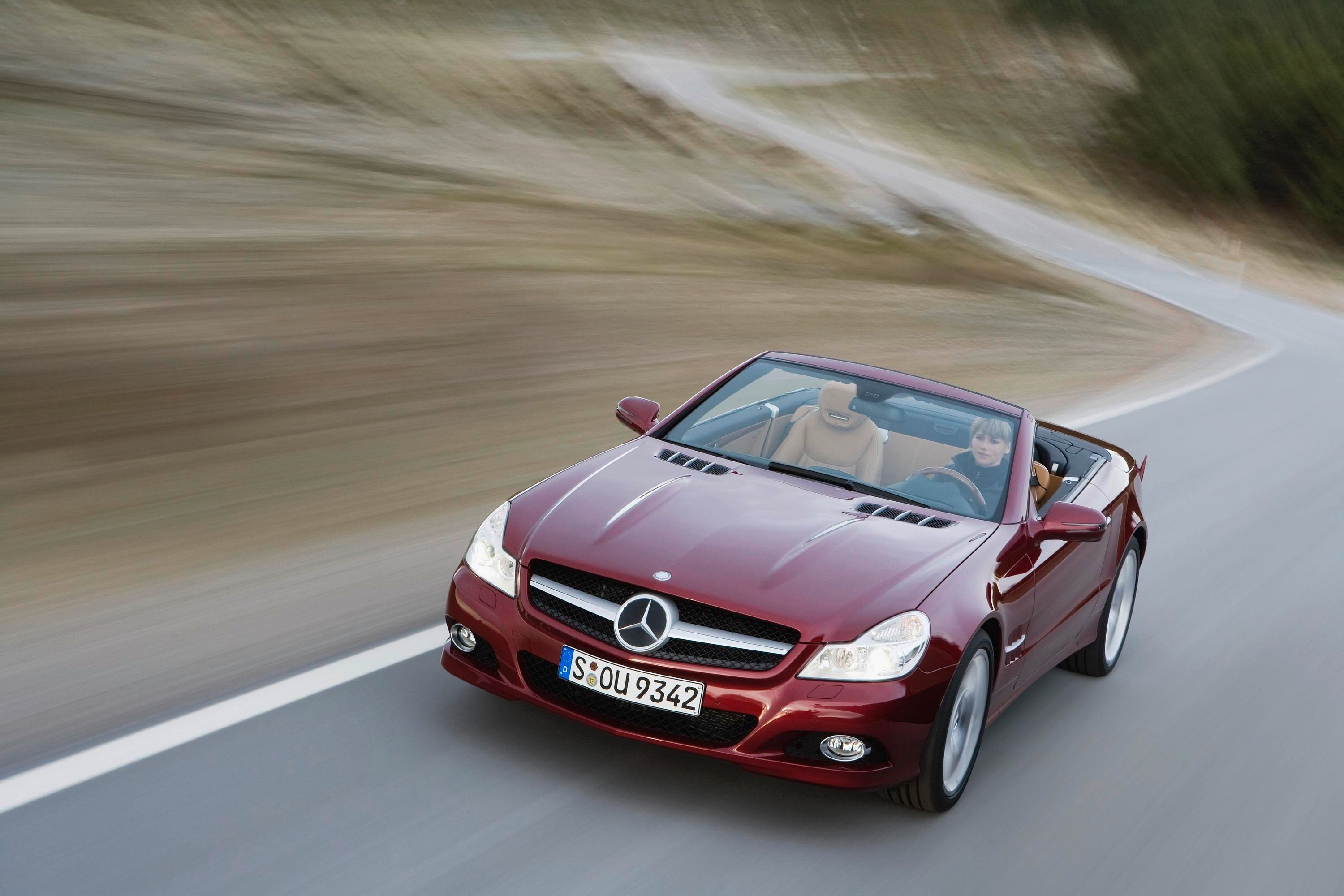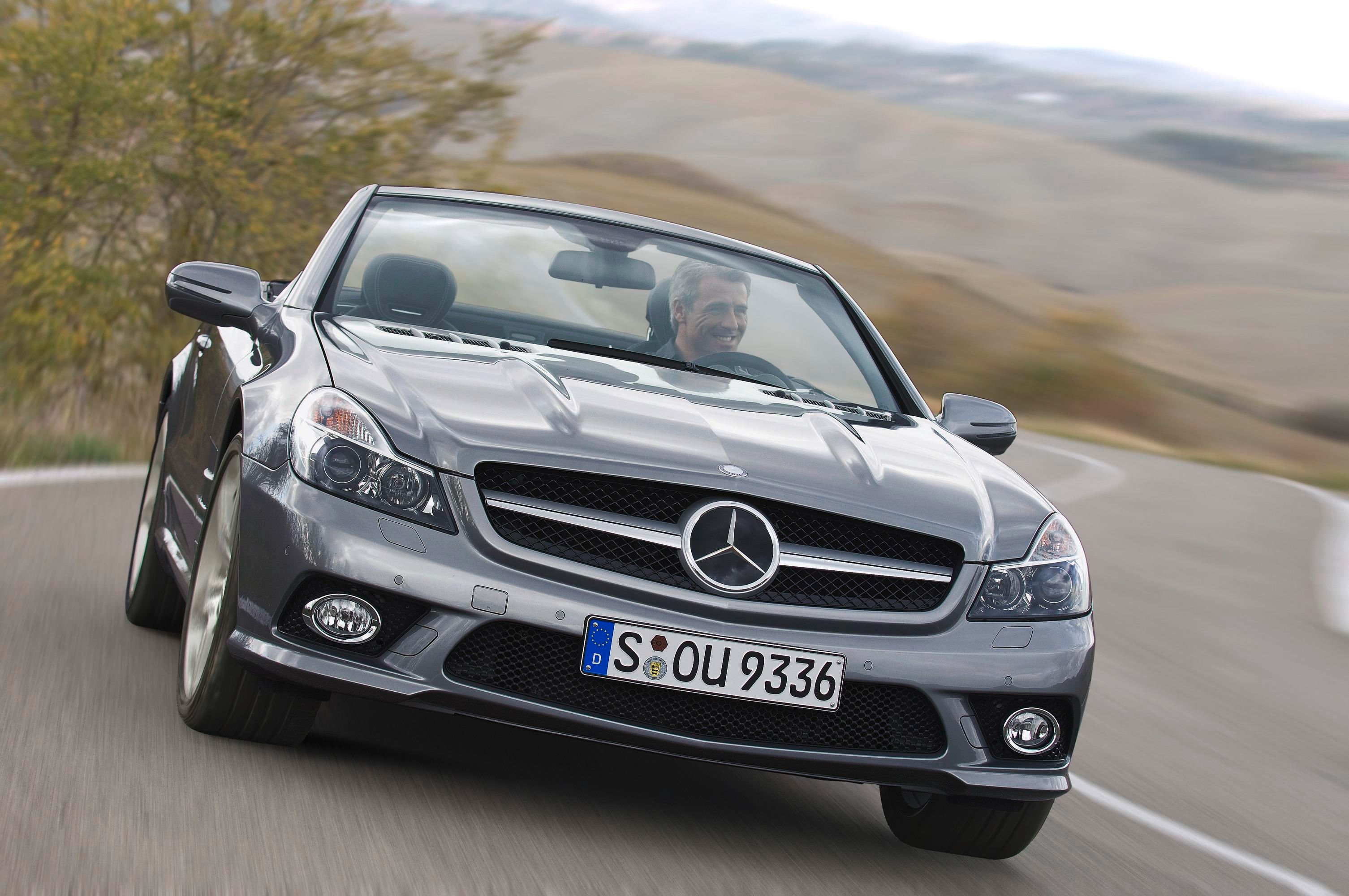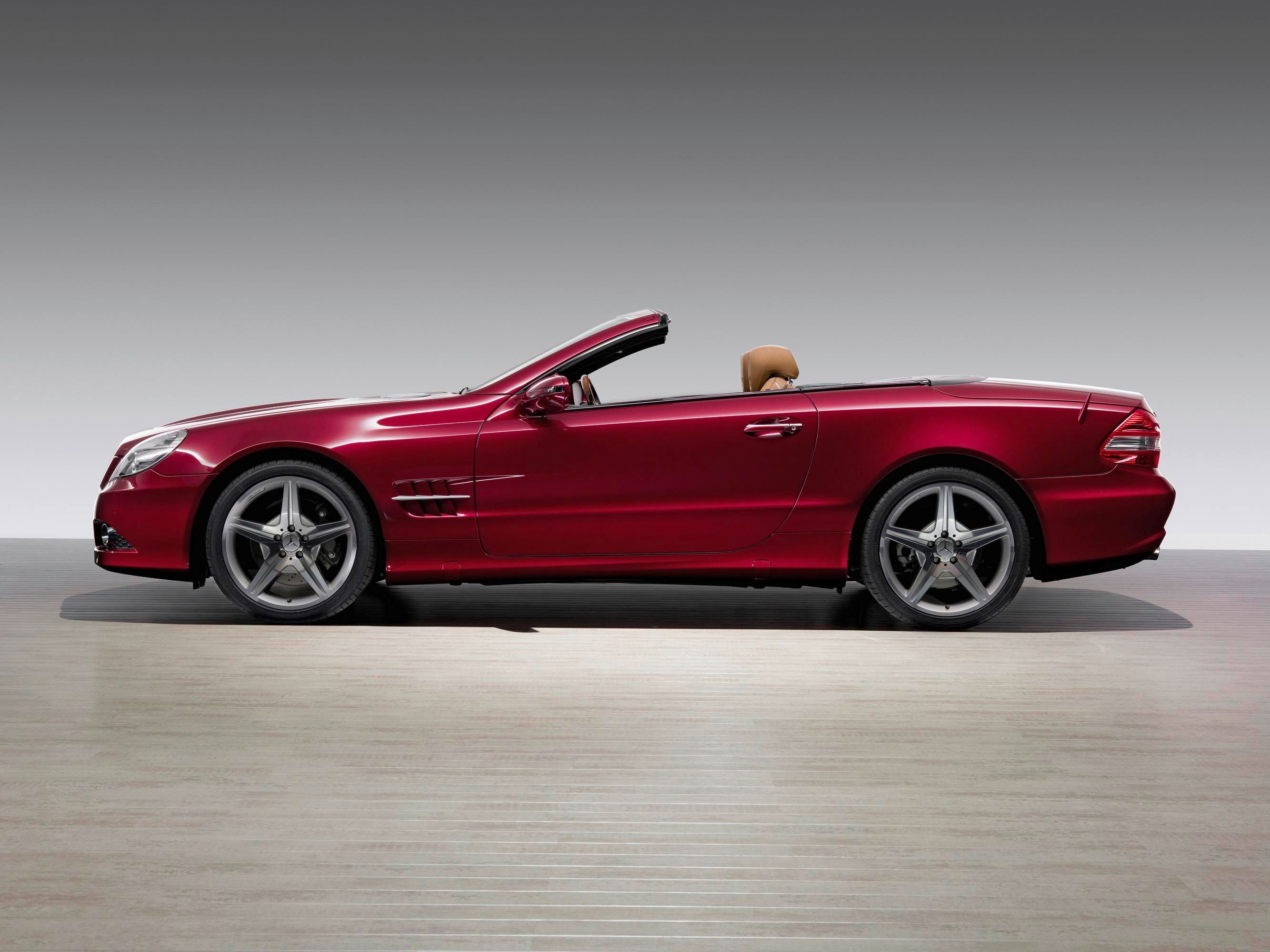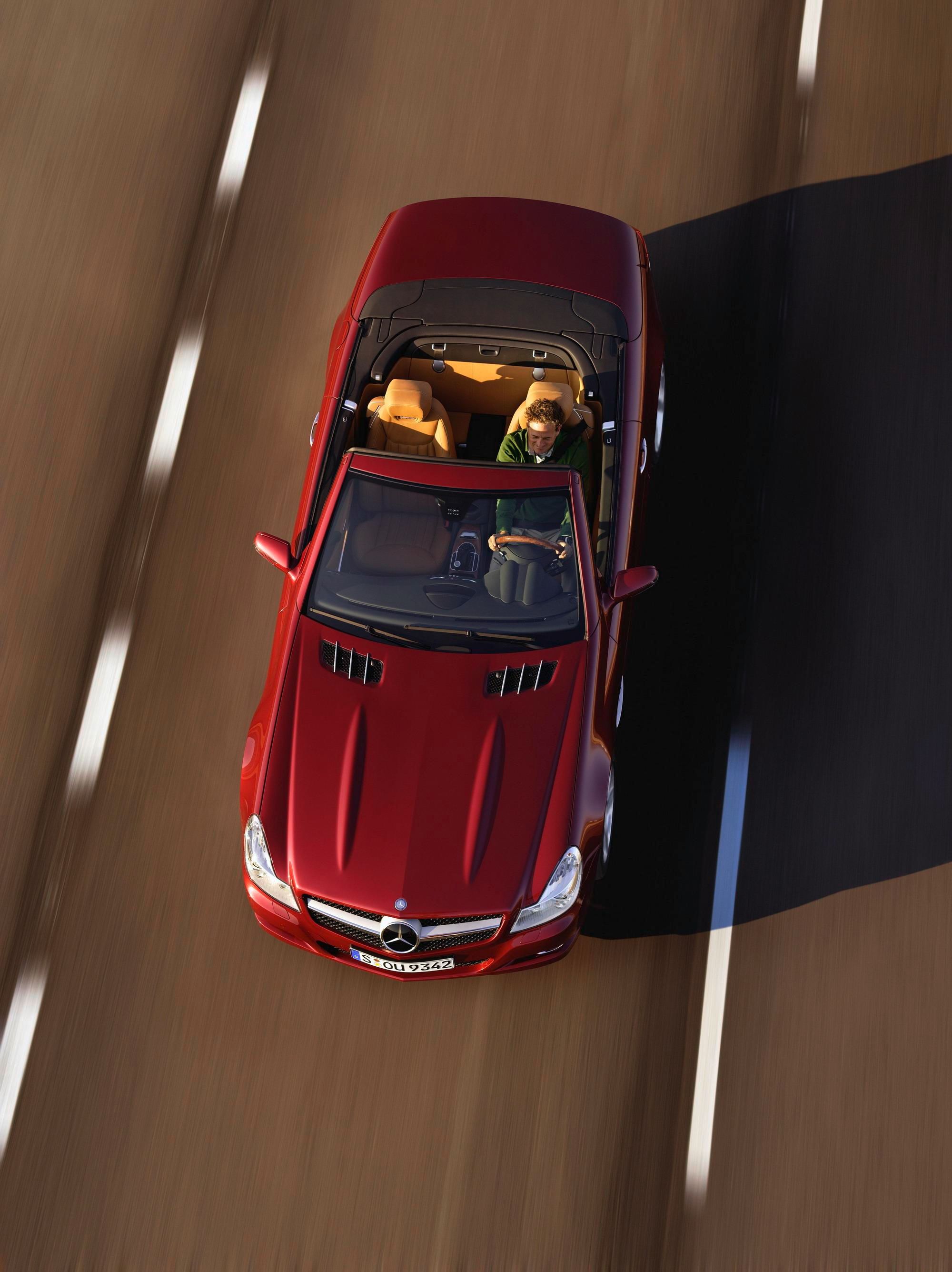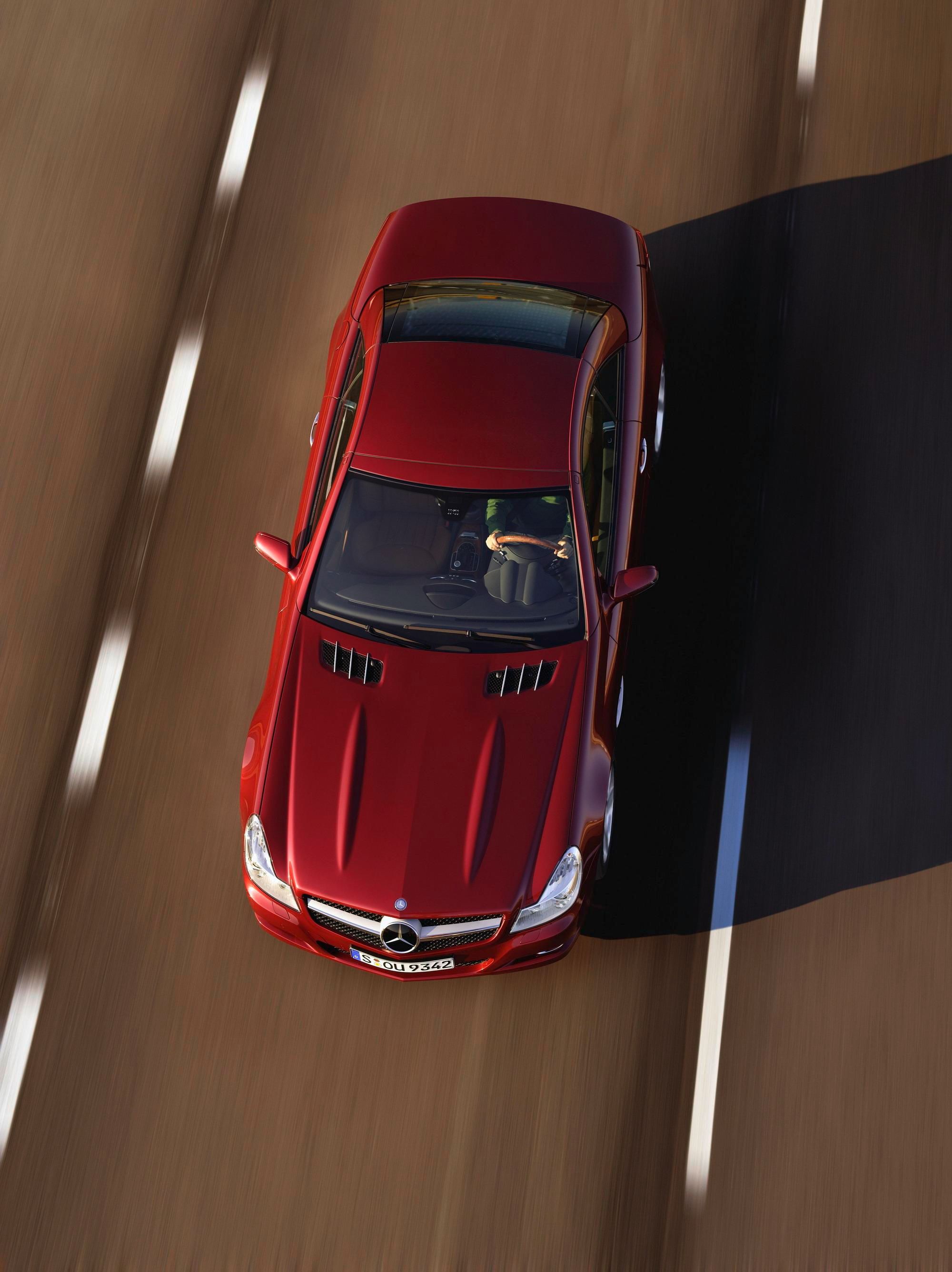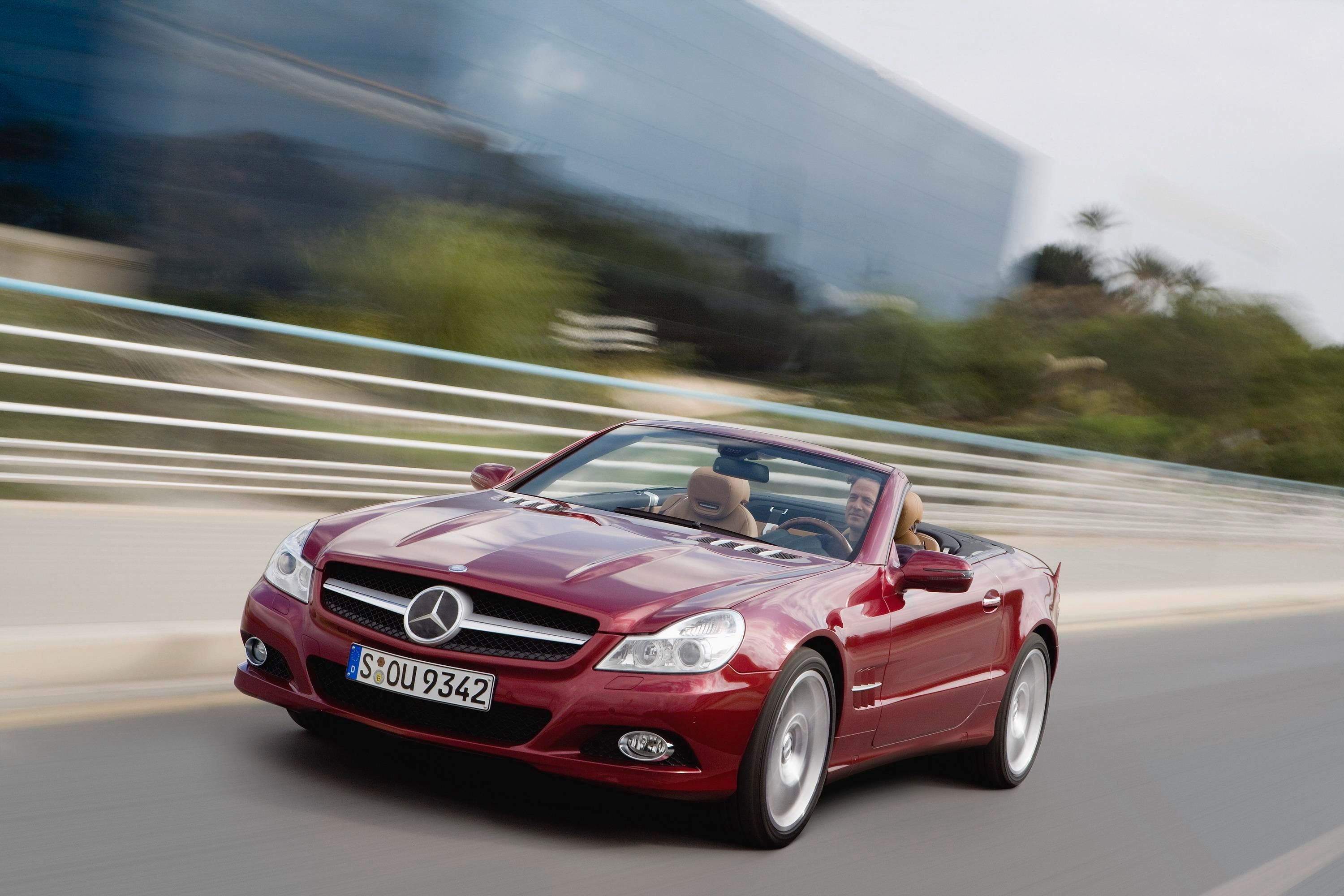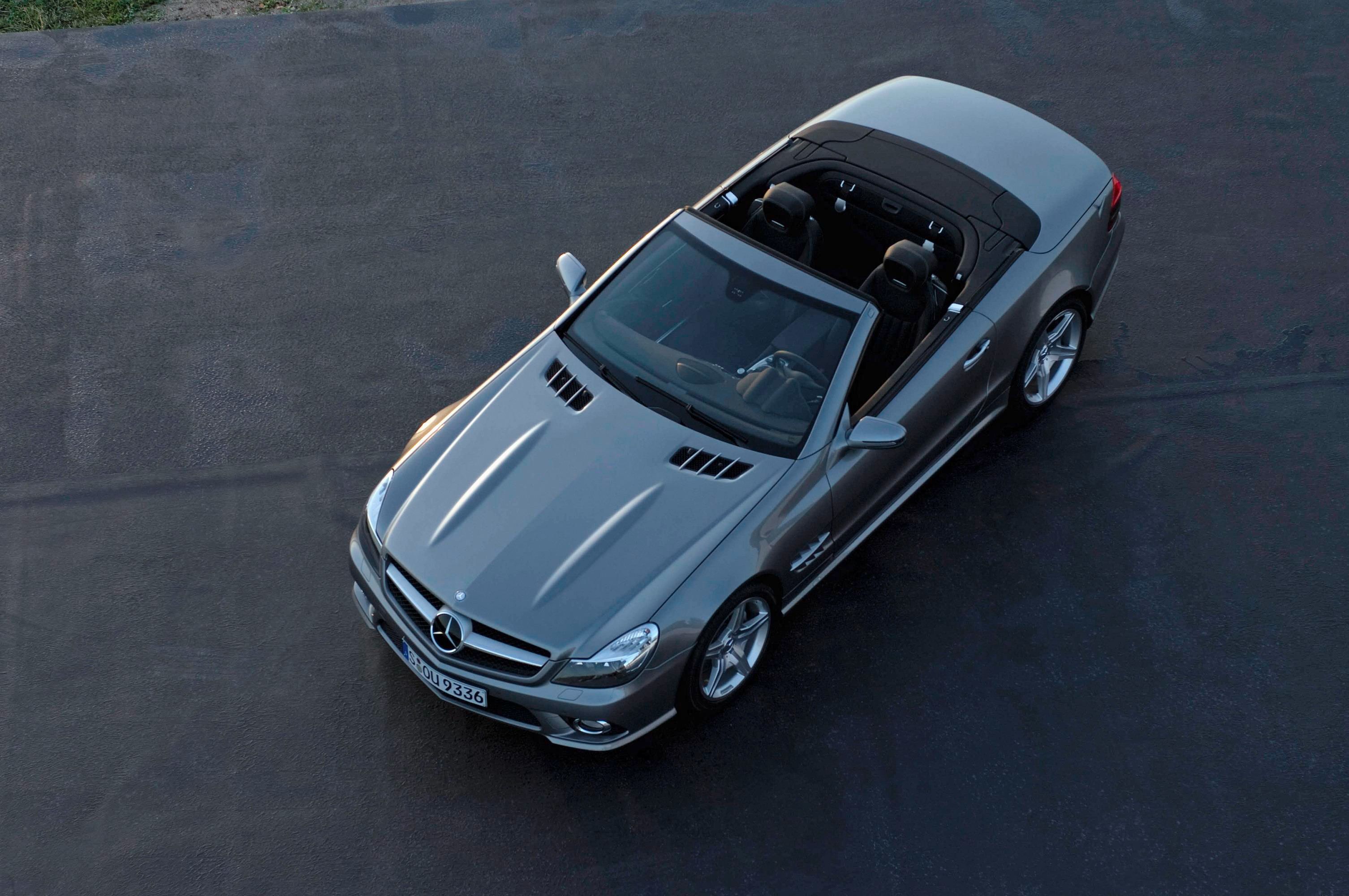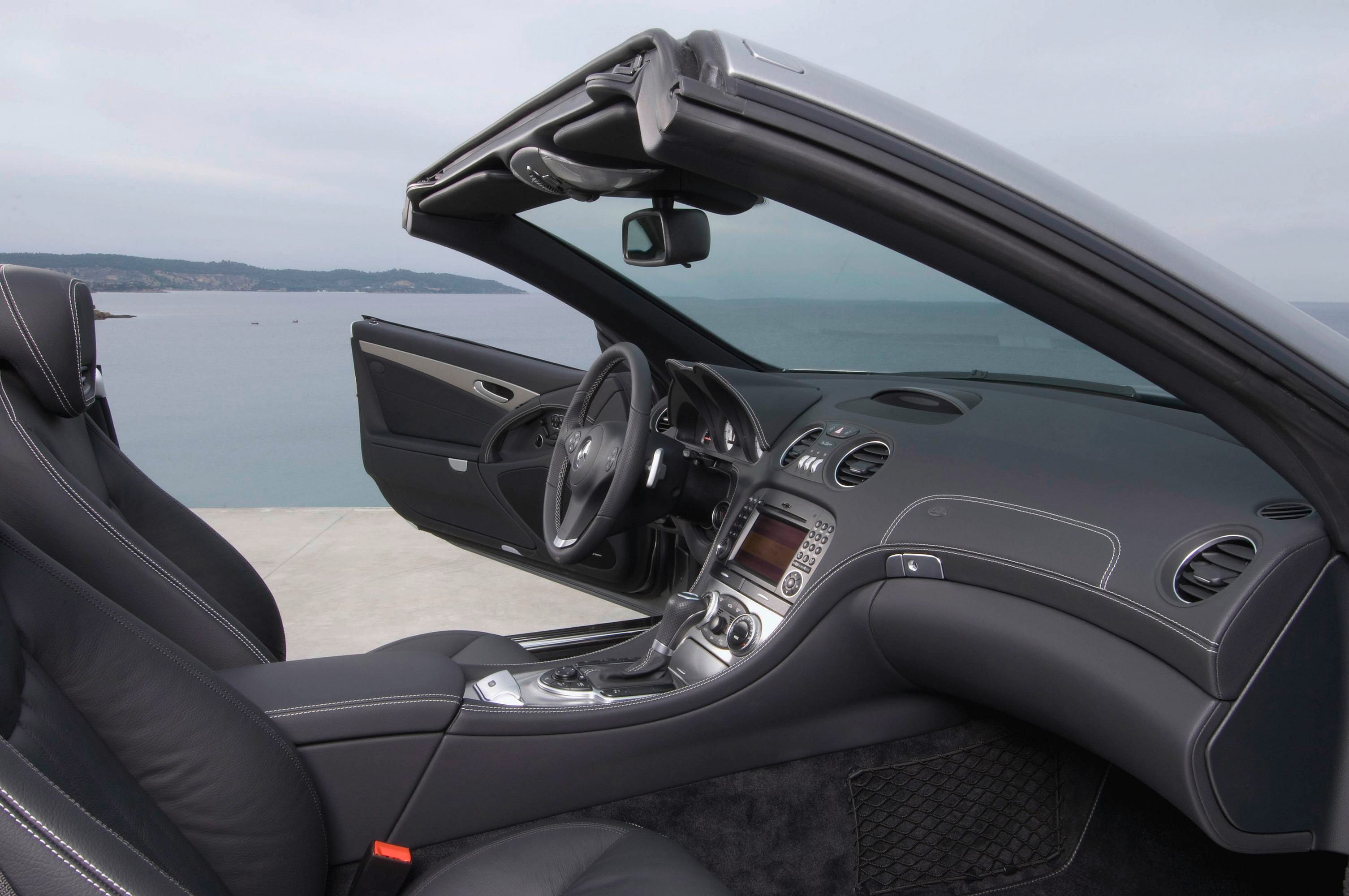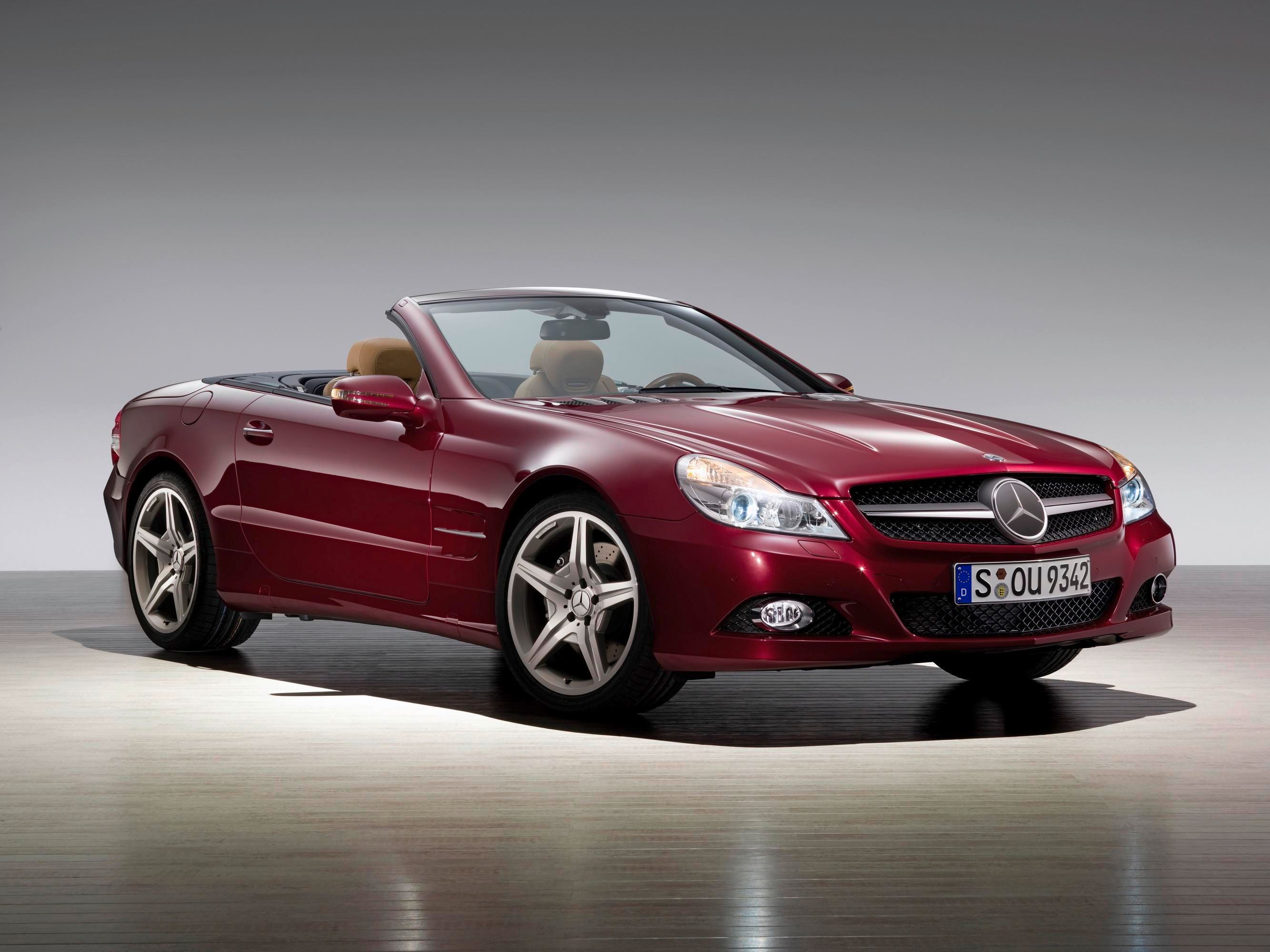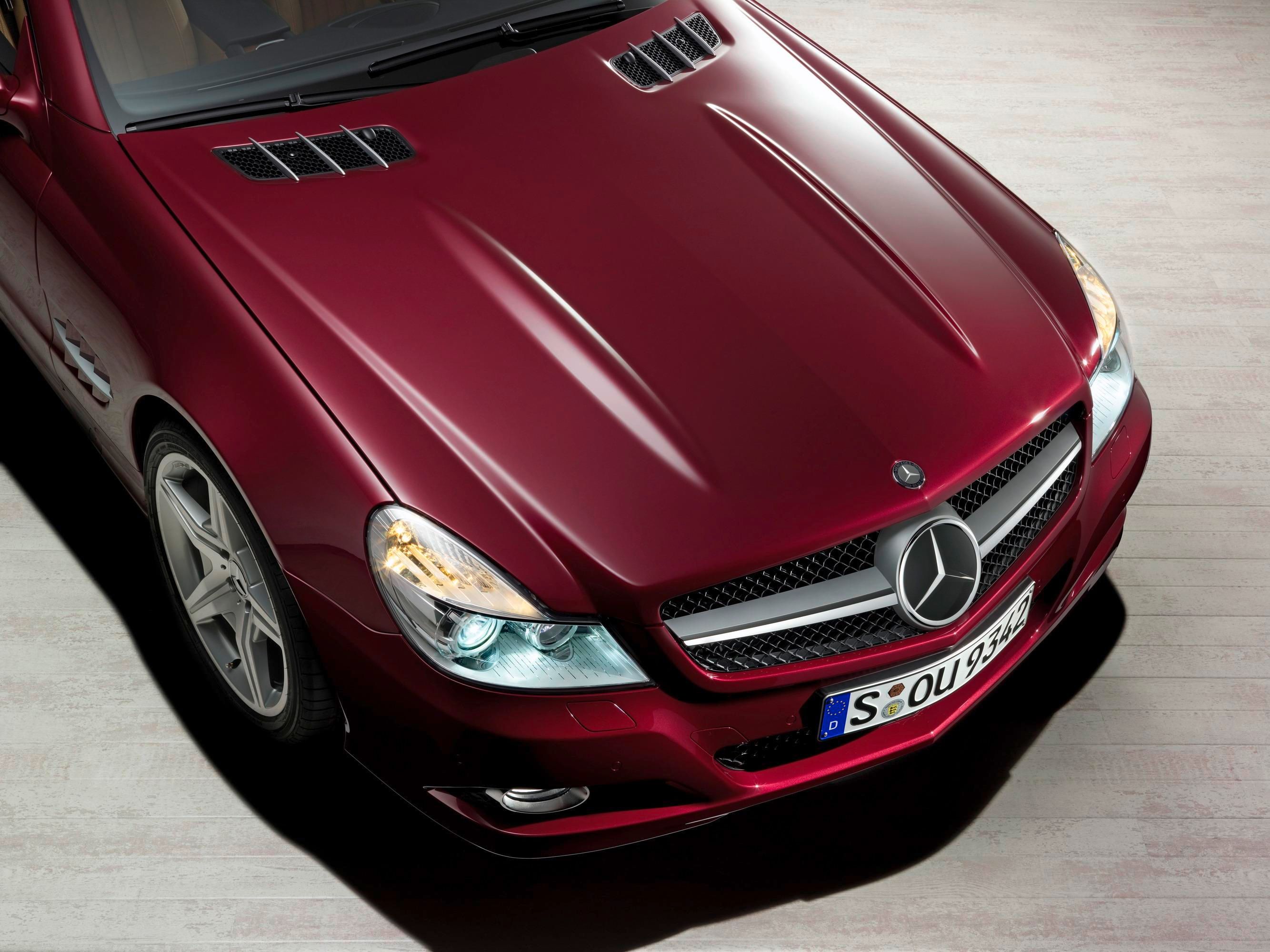Mercedes today unveiled the new generation SL-Class that will make its world debut in March at the Geneva Motor Show. The new generation brings a new design, more sportier and better performance, and also a new entry-level model and a new engine for the SL350.
The 2009 SL-Class features a new front-end design featuring as its centrepiece a wide and, therefore, very dominant radiator grille whose V‑shape symbolises sporty virtues such as forwards thrust and performance potential.
At the rear the new-generation SL demonstrates its sporty nature even more clearly than before. This is achieved above all by a new, diffuser-look bumper which adds a motorsport touch. In conjunction with the equally new trapezoidal exhaust tailpipes this design element emphasises the width of the body, further symbolising the power just waiting to be unleashed by the roadster.
The new version, the SL280 is powered by a V6 engine that delivers 231 hp and a peak torque of 300 Nm from 2500 rpm. The 0 to 60 mph sprint is made in 7.8 seconds, and fuel consumption (NEDC) is just 9.4 litres per 100 kilometres.
The SL350 is powered by a new V6 powerplant that brings the sporty qualities of the new SL generation right to the fore. The engine responds instantaneously to movements of the accelerator pedal and can rev up to 7200 rpm in order to make full use of its power reserves in certain driving situations. Compared to the previous 3.5-litre engine, the output has been boosted by 16 percent to 316 hp (at 6500 rpm), while the peak torque has been increased by 10 Nm and now stands at 360 Nm. This powerplant accelerates the new SL 350 from 0 to 100 km/h in a mere 6.2 seconds.
Top of the class are still the SL500 powered by a V8 engine with an output of 388 hp and the SL600, powered by a V12 engine with an output of 517 hp.
Press release after the jump.
mercedes-sl-class
- Make: Array
- Model: mercedes-sl-class
2009 Mercedes SL-Class
- Make: Array
- Model: 2009 Mercedes SL-Class
- [do not use] Vehicle Model: Array
Press release
Mercedes-Benz will continue its long tradition of producing legendary sports cars when it launches the new-generation SL-Class in spring 2008. The world's most successful premium roadster in its class features a new design with the emphasis firmly on sportiness and effortless assurance. These traits are also reflected in the handling qualities of the two-seater model, which now delivers even more athletic performance thanks to the new direct-steer system as well as offering enhanced comfort and safety. The SL 350 is powered by a newly developed, extremely high-revving sports engine boasting an impressive output of 232 kW/316 hp yet returns a fuel consumption figure that is 0.4 litres per 100 kilometres lower than that of its predecessor (NEDC). 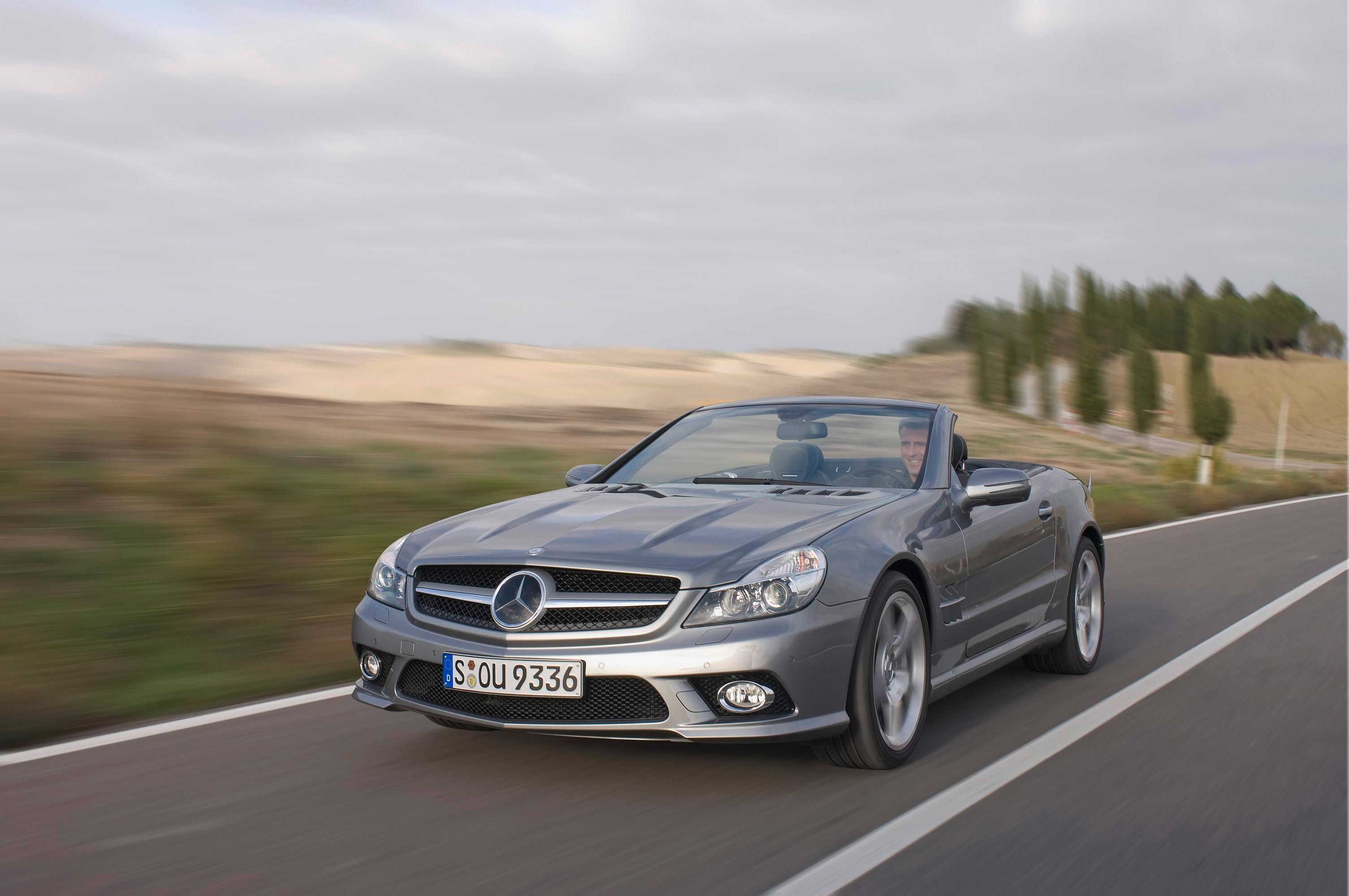 The SL range will now feature two six-cylinder models in the shape of the SL 350 and the new SL 280 (170 kW/231 hp) as well as the familiar SL 500 with a V8 engine and the top-of-the-range SL 600 with a V12 powerplant. The Mercedes sports car extends its lead in the safety stakes courtesy of bi-xenon headlamps, included as standard, and the Intelligent Light System whose light functions are designed specifically for typical driving situations. Further new features on board include AIRSCARF neck-level heating. This system - invented by Mercedes-Benz and available as an optional extra - enhances comfort when driving with the roof down, extending the roadster season until well into the winter months. SL passengers are kept informed and entertained by the standard-fit COMAND multimedia system, which has also been fully redeveloped and features additional functions.
The SL range will now feature two six-cylinder models in the shape of the SL 350 and the new SL 280 (170 kW/231 hp) as well as the familiar SL 500 with a V8 engine and the top-of-the-range SL 600 with a V12 powerplant. The Mercedes sports car extends its lead in the safety stakes courtesy of bi-xenon headlamps, included as standard, and the Intelligent Light System whose light functions are designed specifically for typical driving situations. Further new features on board include AIRSCARF neck-level heating. This system - invented by Mercedes-Benz and available as an optional extra - enhances comfort when driving with the roof down, extending the roadster season until well into the winter months. SL passengers are kept informed and entertained by the standard-fit COMAND multimedia system, which has also been fully redeveloped and features additional functions.
The new-generation SL caps a glorious history of Mercedes sports cars, which began in 1954 with the introduction of the legendary 300 SL "Gullwing", followed in 1957 by the launch of the first SL Roadster. To date, the Stuttgart manufacturer has produced a total of over 630,000 SL sports cars.
Like its predecessors, the new-generation SL also merits its "incomparable" tag. No other sports car in this market segment offers such a perfect balance of sportiness, safety and comfort. These three qualities are the cornerstones of highly eventful, active motoring that provides a profound sense of well-being - for hallmark Mercedes refinement at the highest, sportiest level.
New design idiom with unmistakable sporty overtones
When it came to developing a concept and design for the new-generation SL‑Class, the Mercedes-Benz engineers set out with the aim of accentuating the Roadster's sporty attributes even more strongly than before. This aspiration is reflected in the new front-end design featuring as its centrepiece a wide and, therefore, very dominant radiator grille whose V‑shape symbolises sporty virtues such as forwards thrust and performance potential.
A horizontal louvre makes the radiator grille appear wider and, in doing so, emphasises the powerful aspect of the SL's front end, making it seem surprisingly new yet also very familiar. By using expressive stylistics in this way, the Mercedes designers are able to forge a link with the SL's history and create a front-end design that is reminiscent of the earlier SL Roadster models, which also expressed their poise and assurance through wide, very distinctive radiator grilles. Hence the front-end design of the new-generation SL shows Mercedes-Benz taking the styling of the legendary sports car to the next level.
The designers also pay homage to the forefather of the SL model series: the two powerdomes on the bonnet and the gill-style air outlets in the front wings are unmistakable hallmarks of the 300 SL from 1954 and have been given a modern interpretation for the new Mercedes sports car.
These classic design features drawn from five decades of roadster tradition are
in stylish harmony with new elements of the modern Mercedes design idiom, including the distinctive V-shape of the front section and, above all, the headlamps, which are drawn deeply into the flanks, thus further emphasising the impression of breadth at the front end. As well as giving the SL a highly contemporary look, this striking headlamp design also sees the Roadster continuing its traditional role as a trendsetter. Just like its predecessors, the new‑generation SL features a front-end design that will serve as a template for future Mercedes passenger cars.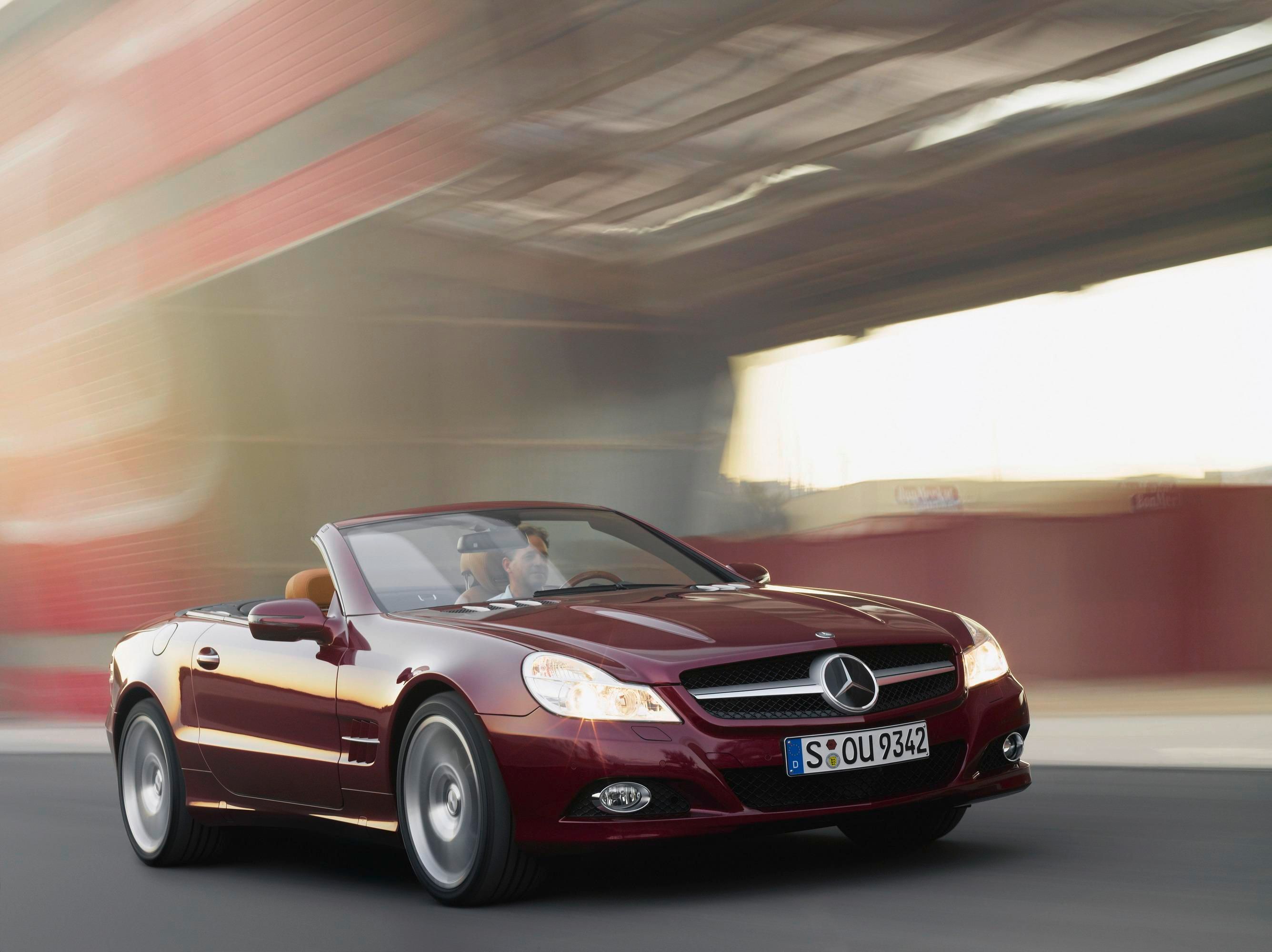 At the rear, too, the new-generation SL demonstrates its sporty nature even more clearly than before. This is achieved above all by a new, diffuser-look bumper which adds a motorsport touch. In conjunction with the equally new trapezoidal exhaust tailpipes this design element emphasises the width of the body, further symbolising the power just waiting to be unleashed by the roadster.
At the rear, too, the new-generation SL demonstrates its sporty nature even more clearly than before. This is achieved above all by a new, diffuser-look bumper which adds a motorsport touch. In conjunction with the equally new trapezoidal exhaust tailpipes this design element emphasises the width of the body, further symbolising the power just waiting to be unleashed by the roadster.
Direct-steer system: consummate sporty driving pleasure
The SL name is synonymous with driving pleasure as well as design. These Mercedes sports cars have always offered a scintillating driving experience that does not deal in compromises - neither in terms of handling dynamics nor by any means when it comes to comfort or safety. It was under this premise that the Mercedes engineers modified and perfected the SL technology, one example being the new, optionally available direct-steer system, which is as simple as it is ingenious and provides a whole new driving experience when cornering.
This new development is based on the familiar standard-fit speed-sensitive power steering system with lower steering forces - the benefit of which is noticeable above all when driving slowly, manoeuvring or parking. New features include a variable rack ratio, which adjusts in line with the steering angle, increasing sharply as soon as this reaches five degrees. All of which means that, compared to a steering system with a constant ratio, the driver does not have to move the steering wheel as much when cornering. The car's response is therefore noticeably more direct, allowing the driver to steer more spontaneously or, in other words, more sportily.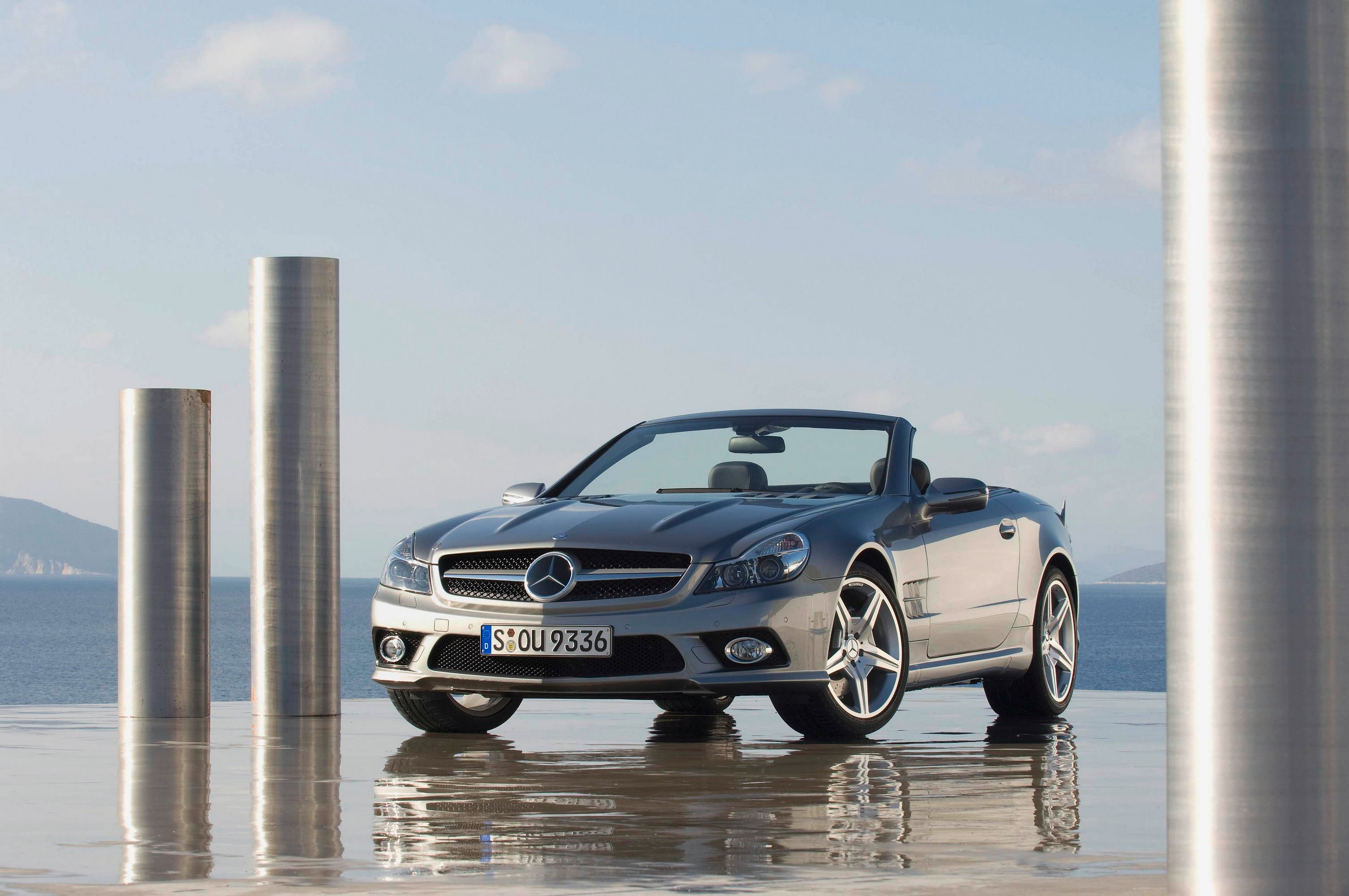 When driving slowly or parking, the new technology combines with the speed-sensitive power steering to provide even more comfort than before because the large ratio further reduces the steering effort required.
When driving slowly or parking, the new technology combines with the speed-sensitive power steering to provide even more comfort than before because the large ratio further reduces the steering effort required.
In addition, the SL still offers some of the very finest chassis technology available in the shape of four-link front suspension and multi-link independent rear suspension. Meanwhile the Active Body Control (ABC) system, specified as standard for the SL 500 and the SL 600, is a unique masterpiece. It compensates pitch, roll and yaw on the part of the body and adapts the suspension settings automatically to suit the current driving situation. This makes for excellent agility on the one hand and optimum driving stability on the other, without compromising the car's super levels of comfort. Mercedes‑Benz has further fine-tuned the ABC shock-absorber settings for the new-generation SL in order to bring a whole new quality to this unique blend of sportiness, comfort and safety.
Size 255/45 R 17 wide-base tyres and 17-inch light-alloy wheels are fitted as standard on the new SL 280 and SL 350 models, whereas the V8-powered SL 500 Roadster runs on 18-inch wheels shod with 255/40 R 18 tyres. And the exclusive character of the twelve-cylinder SL 600 model is accentuated by 18-inch ten-twin-spoke light-alloy wheels with 255/40 R 18 tyres at the front and 285/35 R 18 tyres at the rear.
Engines: new, extremely sporty six-cylinder powerplant
Mercedes-Benz is extending the SL-Class line-up by introducing an attractive entry-level model in the shape of the SL 280 developing 170 kW/231 hp. The six‑cylinder powerplant delivers its peak torque of 300 Nm from 2500 rpm and accelerates the roadster from 0 to 100 km/h in 7.8 seconds, whilst fuel consumption (NEDC) is just 9.4 litres per 100 kilometres.
For the SL 350, the Mercedes engineers have developed a V6 powerplant that brings the sporty qualities of the new SL generation right to the fore. The term "sports engine" could not be more apt: through a process of meticulous engineering, the Stuttgart specialists have further enlivened the temperament of the six-cylinder unit, enhancing its dynamic response dramatically. The engine responds instantaneously to movements of the accelerator pedal and can rev up to 7200 rpm in order to make full use of its power reserves in certain driving situations. Compared to the previous 3.5-litre engine, the output has been boosted by 16 percent to 232 kW/316 hp (at 6500 rpm), while the peak torque has been increased by 10 Nm and now stands at 360 Nm. This powerplant accelerates the new SL 350 from 0 to 100 km/h in a mere 6.2 seconds, making it 0.4 seconds faster than the outgoing SL 350.
In this case, however, the extra power does not come at the expense of fuel economy: with a consumption figure of 9.9 litres per 100 kilometres (NEDC), the new SL 350 undercuts the previous model developing 200 kW/272 hp by 0.4 litres per 100 kilometres.
The sporty character of the V6 power unit is also clearly audible. Its powerfully sonorous sound is the result of meticulous work carried out by sound designers. So these specialists also contribute to the sporty driving pleasure. In this respect, the standard-fit seven-speed automatic transmission also has an important role to play: on the one hand by allowing fast multiple downshifts when accelerating, on the other hand by providing a new double-declutching function that is activated during manual downshifts. As well as producing a sporty sound, this function also enhances comfort and safety as the double-declutching equalises the rotational speeds of the crankshaft and transmission. This set-up gives the driver the advantage of even more harmonious gear changes. Plus there is a noticeable reduction in load-change reactions.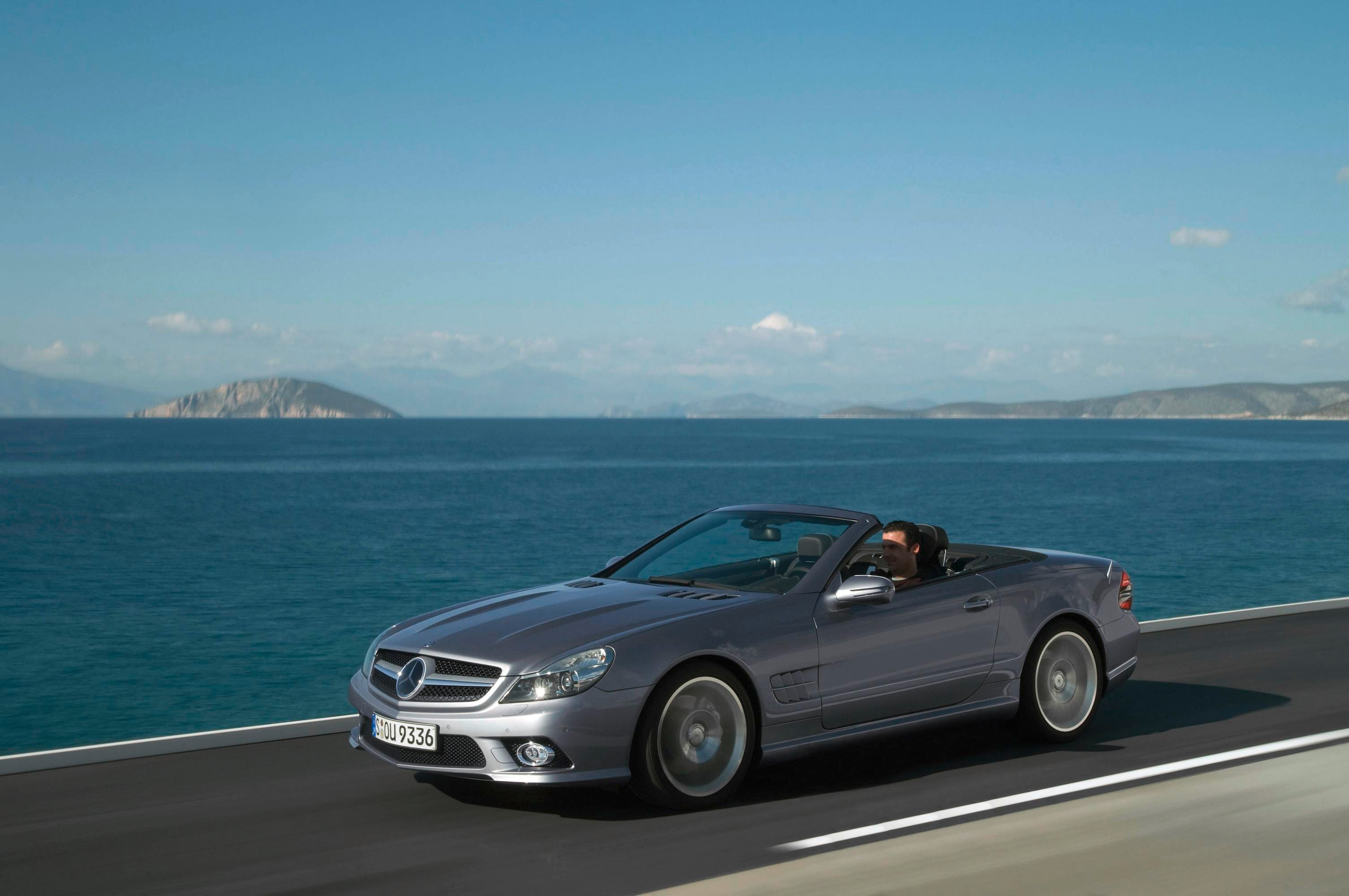 The flagship engines in the SL line-up remain the eight-cylinder unit in the SL 500 developing 285 kW/388 hp and the V12 powerplant in the SL 600, which develops 380 kW/517 hp thanks to its twin turbochargers. The Mercedes engineers also worked meticulously on these models to further reduce fuel consumption by up to 0.4 litres per 100 kilometres.
The flagship engines in the SL line-up remain the eight-cylinder unit in the SL 500 developing 285 kW/388 hp and the V12 powerplant in the SL 600, which develops 380 kW/517 hp thanks to its twin turbochargers. The Mercedes engineers also worked meticulously on these models to further reduce fuel consumption by up to 0.4 litres per 100 kilometres.
Safety: lights for every driving situation, whatever the weather
For five decades, Mercedes sports cars have been setting the pace when it comes to innovative developments in active and passive safety for open-top cars: in the 1960s the SL was the first sports car to feature a safety body based on Béla Barényi's principle, while in the 1970s the SL pointed the way ahead with its three-point inertia-reel seat belts fitted as standard. These developments were followed by ABS and the airbag in the 1980s, while the automatic roll-over bar and the robust integral seats celebrated their world premieres in the early 1990s. The comprehensive range of safety equipment available for the Mercedes sports car was rounded off in 2001 following the introduction of innovations such as adaptive front airbags and head/thorax sidebags.
The new-generation SL continues this tradition, the main focus of the engineers' efforts this time being to improve driving safety at night and in fog. Hence the sports car is equipped as standard with powerful bi-xenon headlamps, which are considerably more powerful and more energy-efficient than comparable LED headlamps. In addition, the optionally available Intelligent Light System provides five different light functions designed specifically for typical driving situations and weather conditions: country mode, motorway mode, enhanced fog lamps, cornering light function and active light function. The variable-control bi-xenon headlamps activate the various light functions automatically. Motorway mode is activated in two stages when the speed exceeds 90 km/h, increasing the driver's range of vision by up to 60 percent.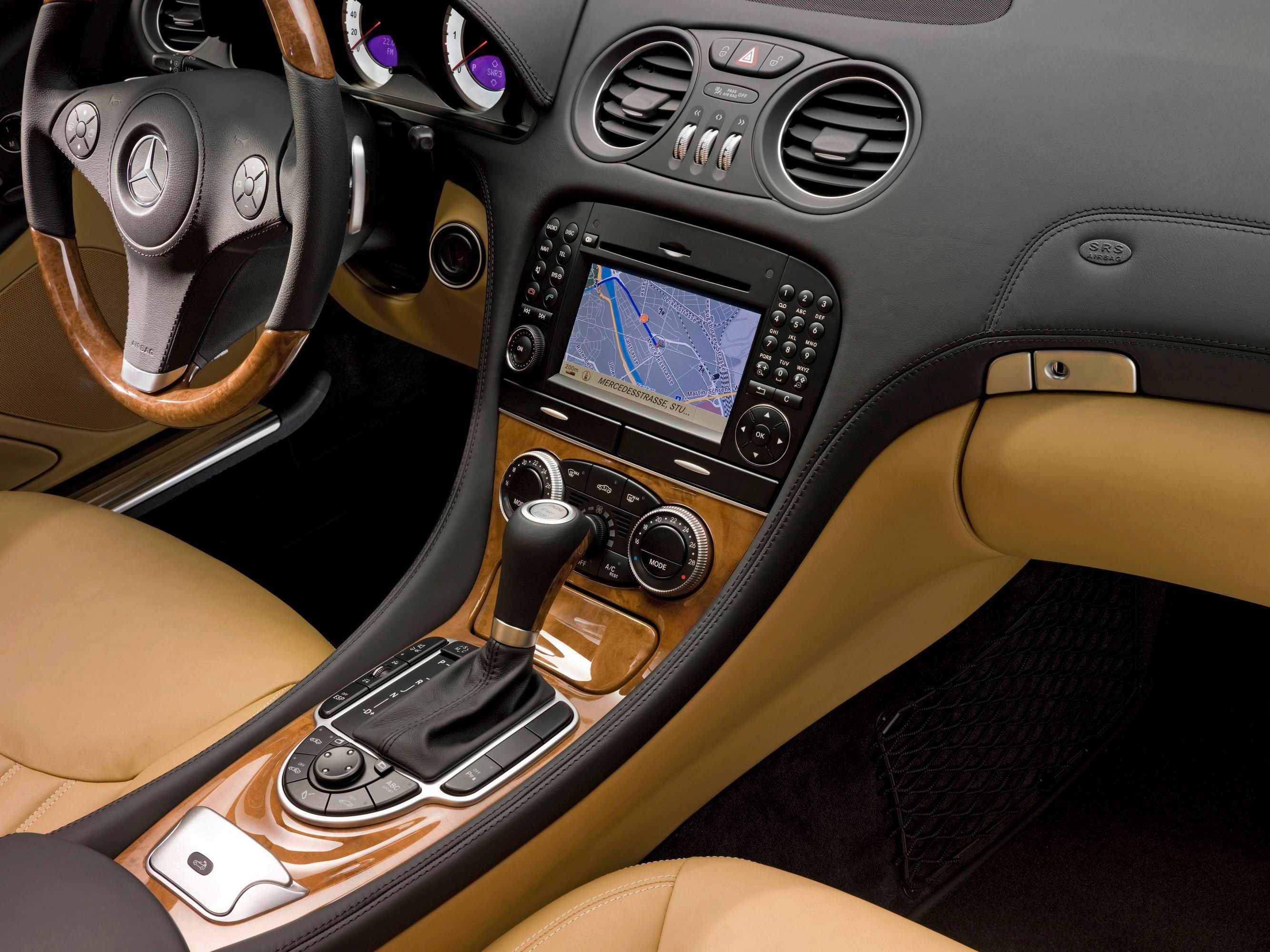 When the active light function is activated, the headlamps pivot to the side in line with the steering angle when the driver enters a bend, allowing them to see around 25 metres further into a long bend than is the case with conventional dipped beam. The cornering light function is activated automatically at speeds below 70 km/h when the driver steers and/or indicates. This means that, as well as enhancing safety when turning at junctions or on slip roads, this light function is also active when cornering at low speed and improves illumination of the areas at the side of the carriageway. The enhanced fog lamps ensure better illumination of the verges, making it easier for drivers to get their bearings. The intelligent headlamp technology installed in the SL can therefore make an important contribution to road safety.
When the active light function is activated, the headlamps pivot to the side in line with the steering angle when the driver enters a bend, allowing them to see around 25 metres further into a long bend than is the case with conventional dipped beam. The cornering light function is activated automatically at speeds below 70 km/h when the driver steers and/or indicates. This means that, as well as enhancing safety when turning at junctions or on slip roads, this light function is also active when cornering at low speed and improves illumination of the areas at the side of the carriageway. The enhanced fog lamps ensure better illumination of the verges, making it easier for drivers to get their bearings. The intelligent headlamp technology installed in the SL can therefore make an important contribution to road safety.
Interior: sporty ambience and hallmark Mercedes comfort
A look inside the new-generation SL shows what Mercedes designers mean when they talk about the "balance of sportiness and comfort". The integral seats, the new-look three-spoke leather steering wheel and the completely restyled instrument cluster immediately make it clear that this is a thoroughbred sports car. Everything fits perfectly, all the controls are easy to see and within just as easy reach. The speedometer and rev counter sport a classic chronometer design with new-look dials that promise unerring precision.
As soon as the ignition is switched on, the cockpit instruments grab the driver's attention: the red speedometer and rev counter needles are aroused from their "six o' clock position", rotate once around the dials to their maximum values and then revert to their zero positions. The message these needle movements convey to the driver is unmistakable: "start your engine".
A wide range of colours and materials allows Mercedes customers to design and appoint the interior of the new-generation SL to their individual tastes. There are two types of leather to choose from, as well as five different aluminium or fine-wood trims and five colour combinations. The interior looks especially luxurious and refined when specified with the new natural beige/black colour scheme and the new wood trim elements in pale burr walnut with a high-sheen finish.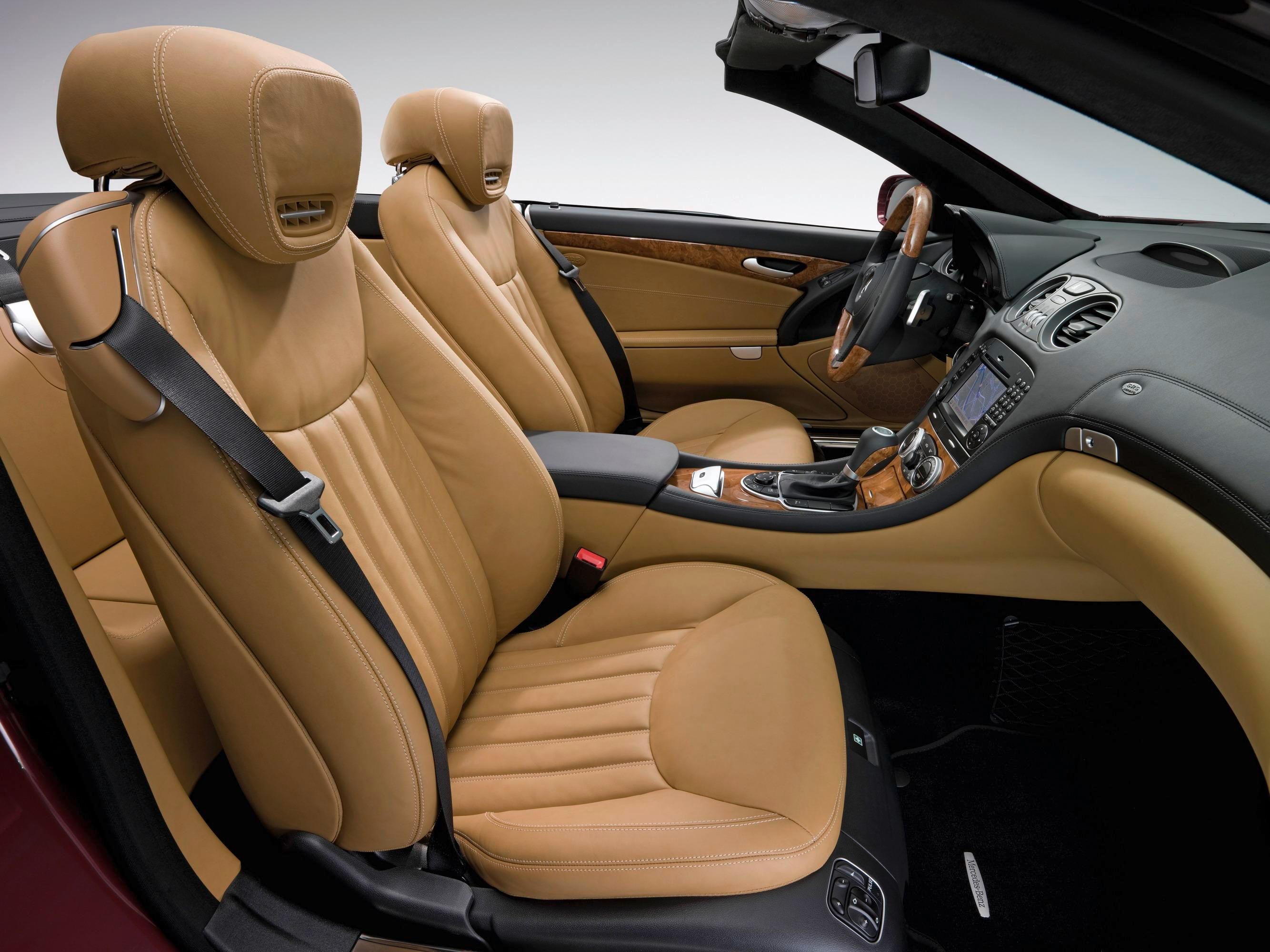 The SL 600 underlines its top billing in the SL line-up even more clearly than before. Inside the passengers are cosseted by extremely soft Exclusive nappa leather and trim elements in elegant poplar wood. V12 emblems on the seat backrests, on the centre steering wheel spoke and on the door sills, as well as the uniquely designed interior door panels round off the refined twelve-cylinder ambience perfectly. On the outside, the flagship SL model is distinguishable by its exclusive 18-inch ten-twin-spoke light-alloy wheels and discreet yet highly effective detailing such as the matt-silver-painted louvres of the side air outlets and the centre divider in the trapezoidal exhaust tailpipe trims. Mercedes-Benz has upgraded the already extensive standard-equipment package by adding the KEYLESS-GO system and a remote-locking boot lid.
The SL 600 underlines its top billing in the SL line-up even more clearly than before. Inside the passengers are cosseted by extremely soft Exclusive nappa leather and trim elements in elegant poplar wood. V12 emblems on the seat backrests, on the centre steering wheel spoke and on the door sills, as well as the uniquely designed interior door panels round off the refined twelve-cylinder ambience perfectly. On the outside, the flagship SL model is distinguishable by its exclusive 18-inch ten-twin-spoke light-alloy wheels and discreet yet highly effective detailing such as the matt-silver-painted louvres of the side air outlets and the centre divider in the trapezoidal exhaust tailpipe trims. Mercedes-Benz has upgraded the already extensive standard-equipment package by adding the KEYLESS-GO system and a remote-locking boot lid.
AIRSCARF: Mercedes invention extends the open-air season
The long list of systems that help to provide an outstanding level of comfort in the roadster includes a further innovation in the new-generation SL. AIRSCARF - the neck-level heating system developed and patented by Mercedes engineers - is so called because it distributes air at just the right temperature through the head restraints, forming a warm, invisible "scarf" around the driver and front passenger.
This Mercedes-Benz invention allows the occupants to enjoy open-air driving pleasure for longer and even more often than before. The roadster season lasts until well into the winter months as AIRSCARF provides the SL occupants with all the warmth they need.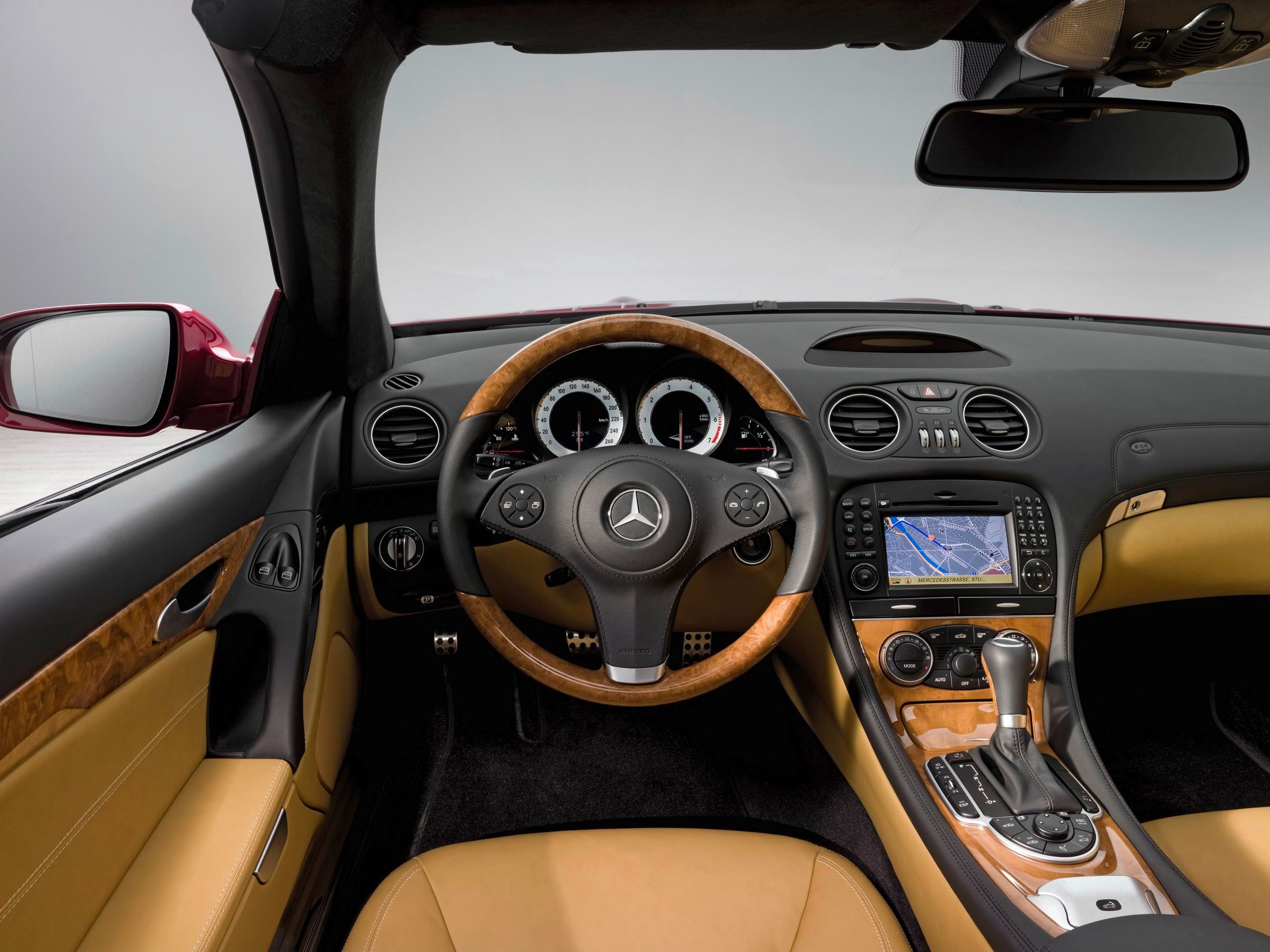 The optionally available heating system, which celebrated its world premiere in the SLK Roadster in 2004, has been modified by the Mercedes engineers for the new SL generation. Now the blower and heating are incorporated in the head restraints of the integral seats: two small ventilators suck in air behind the head restraints and channel it through the electric heating element to ensure rapid heating. The temperature-controlled air then flows out of special openings on the front of the head restraints and warms the occupants' head and neck areas. Both driver and passenger can select the heating temperature using a three-position switch in the door lining; the system then controls the desired temperature automatically depending on the speed at which the car is being driven.
The optionally available heating system, which celebrated its world premiere in the SLK Roadster in 2004, has been modified by the Mercedes engineers for the new SL generation. Now the blower and heating are incorporated in the head restraints of the integral seats: two small ventilators suck in air behind the head restraints and channel it through the electric heating element to ensure rapid heating. The temperature-controlled air then flows out of special openings on the front of the head restraints and warms the occupants' head and neck areas. Both driver and passenger can select the heating temperature using a three-position switch in the door lining; the system then controls the desired temperature automatically depending on the speed at which the car is being driven.
Infotainment: latest multimedia technology in the centre console
The new-generation SL is also fit for the future when it comes to information, entertainment and communications: Mercedes-Benz has further modified the standard-fit COMAND system, equipping it with additional functions. The result is infotainment par excellence: the multimedia device combines a car radio including a dual tuner with telephone controls, a CD/DVD changer and a slot for SD memory cards. Further new additions include a Bluetooth receiver, which connects a mobile phone to the standard-fit hands-free system wirelessly, and a large colour display (6.5"), which enhances user-friendliness and serves as a high-resolution screen for playing DVD films - although not whilst the car is being driven, for obvious safety reasons.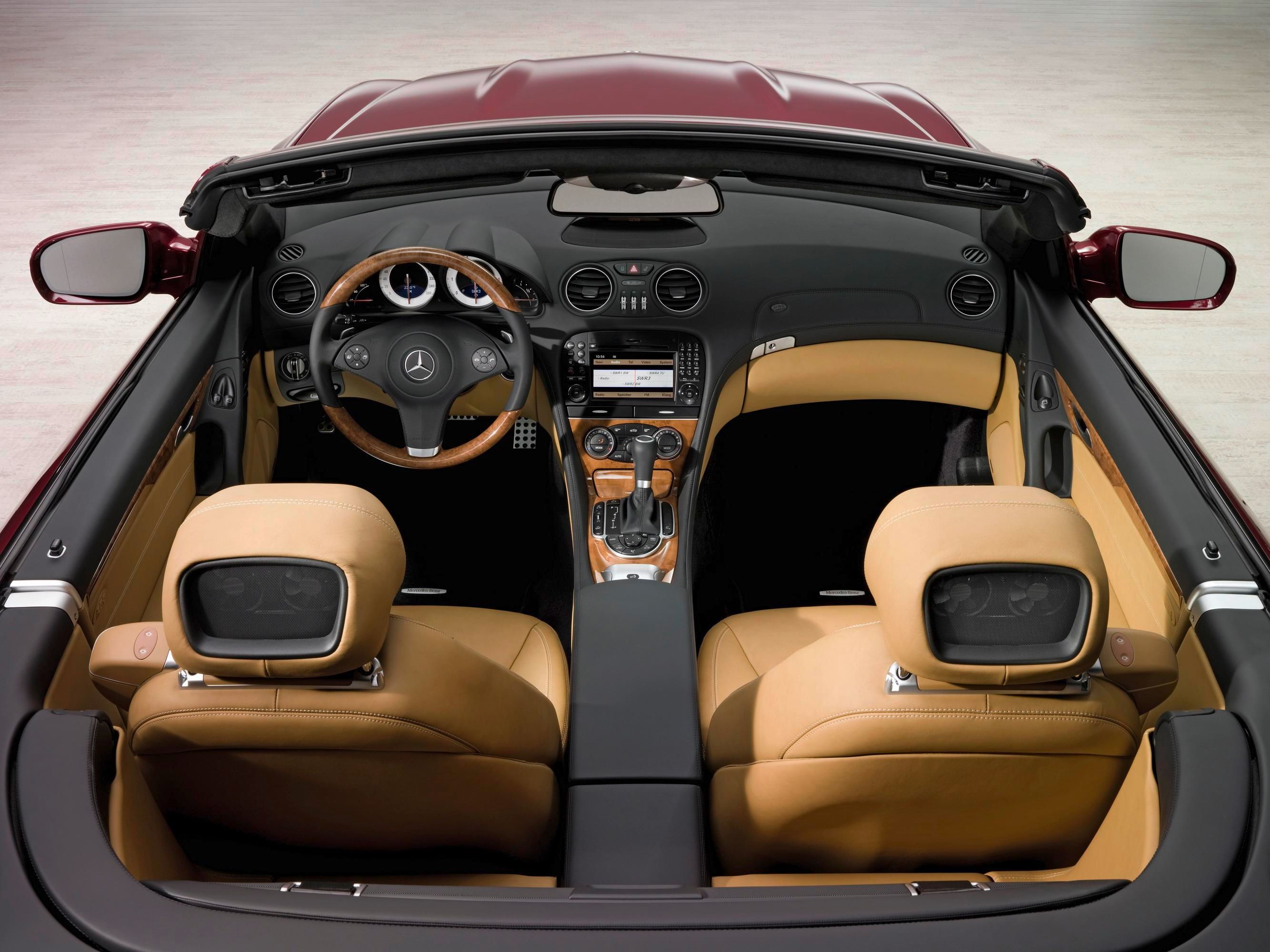 An even wider range of high-tech electronics is available ex factory: Mercedes customers can now order the optional COMAND APS system. Its additional features include a Europe-wide navigation system whose data are stored on a hard disc and therefore allow extremely fast route calculations. For playing music, there is an integrated six-disc CD/DVD changer and a Music Register for around 1000 MP3 tracks. A saved database enables automatic recognition of the music tracks and their artists. This information is then posted on the colour display.
An even wider range of high-tech electronics is available ex factory: Mercedes customers can now order the optional COMAND APS system. Its additional features include a Europe-wide navigation system whose data are stored on a hard disc and therefore allow extremely fast route calculations. For playing music, there is an integrated six-disc CD/DVD changer and a Music Register for around 1000 MP3 tracks. A saved database enables automatic recognition of the music tracks and their artists. This information is then posted on the colour display.
The standard COMAND APS package also includes the latest-generation LINGUATRONIC voice-operated control system, which controls the navigation, telephone and audio systems based on its ability to recognise entire words. This system is of great benefit as drivers no longer need to spell out their commands. Instead, they simply say what they want, whether it be a destination for the navigation system, a radio station or a name in the stored phone book.
For the first time, it is also possible to connect an iPod, USB stick or other external audio device to the COMAND system thanks to a newly developed, universal media interface in the centre console (optional). This UCI (Universal Consumer Interface) is more than just an electronic "socket", however; it also includes an ECU that links the external music memory to the SL's on-board electronics and control system. In this way, the iPod music tracks can also be indicated on the instrument cluster and on the COMAND display in the centre console. Plus they can be called up easily using the buttons on the multifunction steering wheel. The audio device's battery is charged for as long as the portable music memory is connected to the car via the UCI.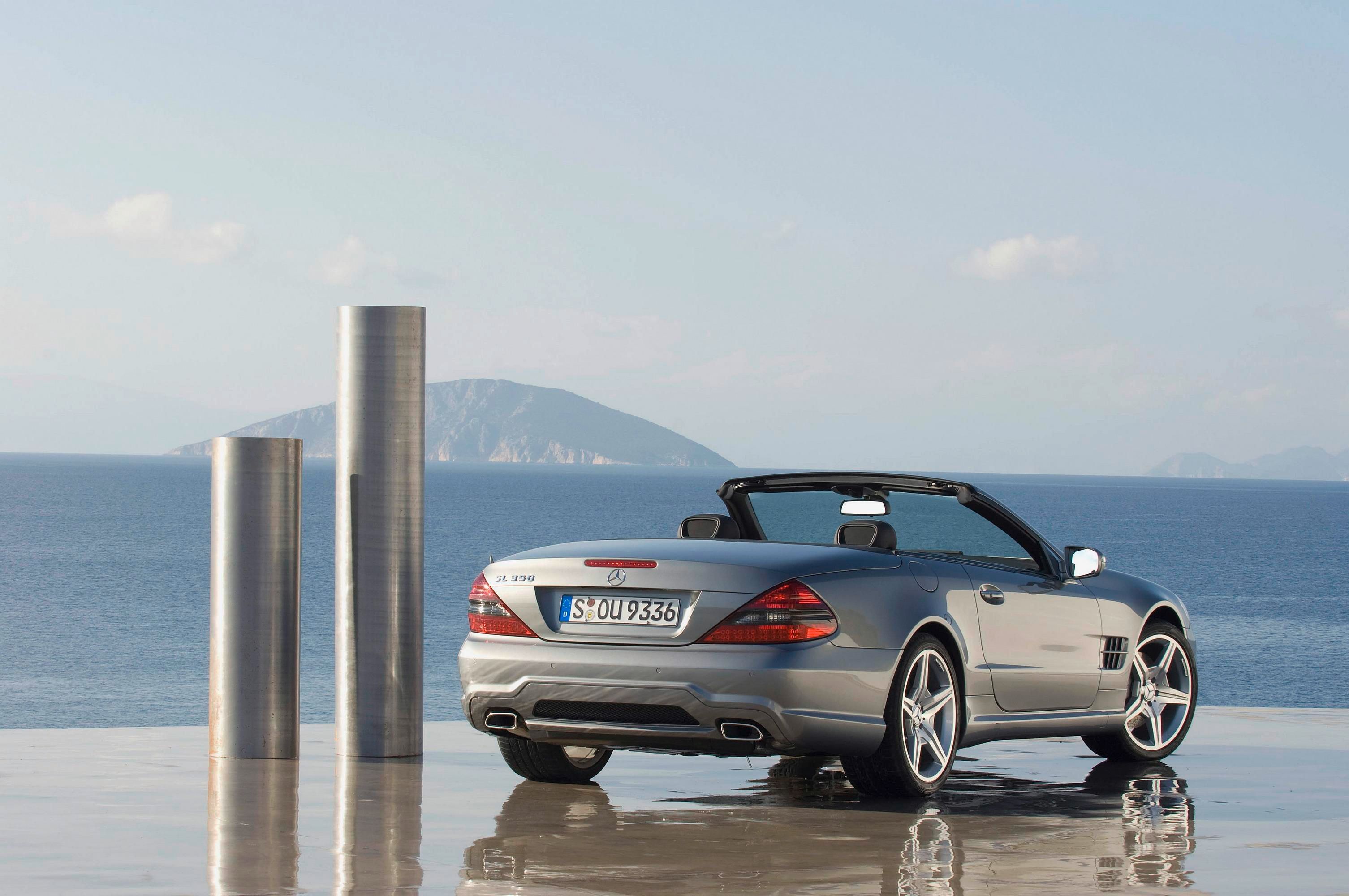 For a complete in-car music experience, Mercedes-Benz can equip the new-generation SL with the Harman Kardon "Logic7" sound system (optional extra), which is also used in the S-Class and whose performance has been confirmed in numerous tests. The sound system has an output of 510 watts and converts the SL interior into a mobile concert hall - whether the vario-roof is up or down - courtesy of ten high-performance loudspeakers and state-of-the-art surround technology.
For a complete in-car music experience, Mercedes-Benz can equip the new-generation SL with the Harman Kardon "Logic7" sound system (optional extra), which is also used in the S-Class and whose performance has been confirmed in numerous tests. The sound system has an output of 510 watts and converts the SL interior into a mobile concert hall - whether the vario-roof is up or down - courtesy of ten high-performance loudspeakers and state-of-the-art surround technology.
The new-generation SL-Class will make its public debut in March at the International Motor Show in Geneva. It will then appear at Mercedes-Benz outlets and dealerships in Europe from April 5, 2008.

